There are so many battles between animals in the wild, it makes us wonder about hypotheticals. For example, what if a great white shark battled 100 piranhas? Who knows what would happen!
Today, we thought we’d take a look at a battle between 10 leopard seals and a solo great white shark. We all know that the great white shark has been an apex predator for hundreds of years.
Could a single one of these animals take on 10 leopard seals? That’s what we’re here to find out!
Comparing Leopard Seals and Great White Sharks
| Factor | Leopard Seal | Great White Shark |
|---|---|---|
| Size | Weight: Up to 800 pounds Length: 8 to 13 feet | Weight: 1,500 to 2,400 pounds Length: 11 to 16 feet |
| Speed | Bursts up to 25 miles per hour Can reach 35 miles per hour on land | Bursts up to 35 miles per hour Casual speeds: 20 miles per hour |
| Defenses | Hard bite Trashes violently Slams head against other animals Powerful jaw Long teeth | Can roll its eyes backward for protection Body clams Vicious bite Camouflage from above |
| Offenses | Very fast swimmers Rubbery skin Can move easily in small spaces | Can breach the surface of the water Swims incredibly fast Thick skin Attacks from underneath |
| Predatory Behavior | Extremely solitary Ambush predatorsStalks fish | Relatively solitary Can migrate widely Deep dives for food Bites and retreats |
What Are the Key Differences Between Leopard Seals and Great White Sharks?
One of the greatest differences between these two animals is that leopard seals are incredibly agile. This allows them to move in ways that a great white simply cannot. These seals can swim in smaller places, maneuver around sharks, and more.
Which animal prevails in the competition between the 10 feisty leopard seals and a massive great white shark will be heavily influenced by these special characteristics. But we also need to look into alternative possibilities.
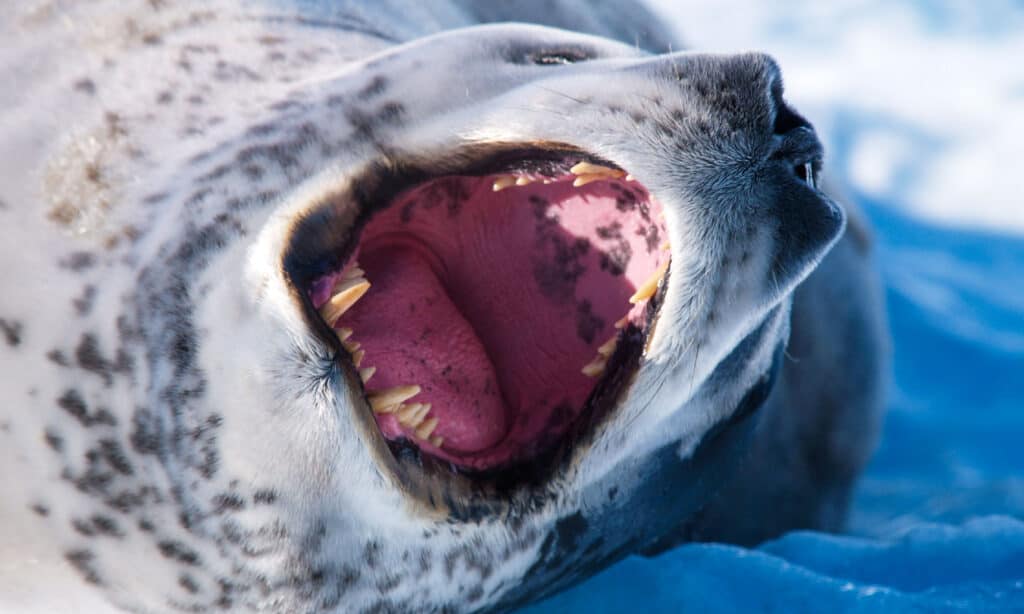
Leopard seals can often be seen smiling.
©Yvonne Schonewille/Shutterstock.com
It is important to take into account a variety of elements when deciding which animal will prevail in a fight. The outcome of the Great White vs. 10 leopard seals contest will be decided by a combination of five separate factors.
We’ll provide you with information about each creature and demonstrate which one has the upper hand in all categories. Let’s take a look at the factors to consider to see which of these sea creatures would win in a not-so-hypothetical fight!
Leopard Seals vs. Great White Sharks: Size
Leopard seals are normally a little smaller than great white sharks. Based on the aforementioned average size, it would seem obvious that great white sharks are larger than leopard seals. Leopard seals are among the largest seals in the world, growing to a maximum length of 12 feet and a weight of 1,320 pounds.

Fish constantly swim around sharks in hopes of getting scraps.
©iStock.com/Martin Heyn
The white shark weighs around 4,000 pounds at max. When it is born the great white is about four feet long. That being said, 10 leopard seals would not only outnumber a great white but would outweigh one as well.
Leopard Seals vs. Great White Sharks: Speed and Movement
Like all real seals, the leopard seal is well-suited for life in the water. Its body is sleek and torpedo-shaped, and it swims throughout the water by swiping its back flippers. The front flippers serve as tools for navigation, and because they are so lengthy, they make it easier for the seal to rapidly change directions.
This is essential when pursuing fast-swimming food or escaping a predator like a great white shark. When pursuing its prey, a leopard seal can reach speeds up to 24 miles per hour, which is a little quicker than the quickest penguin.
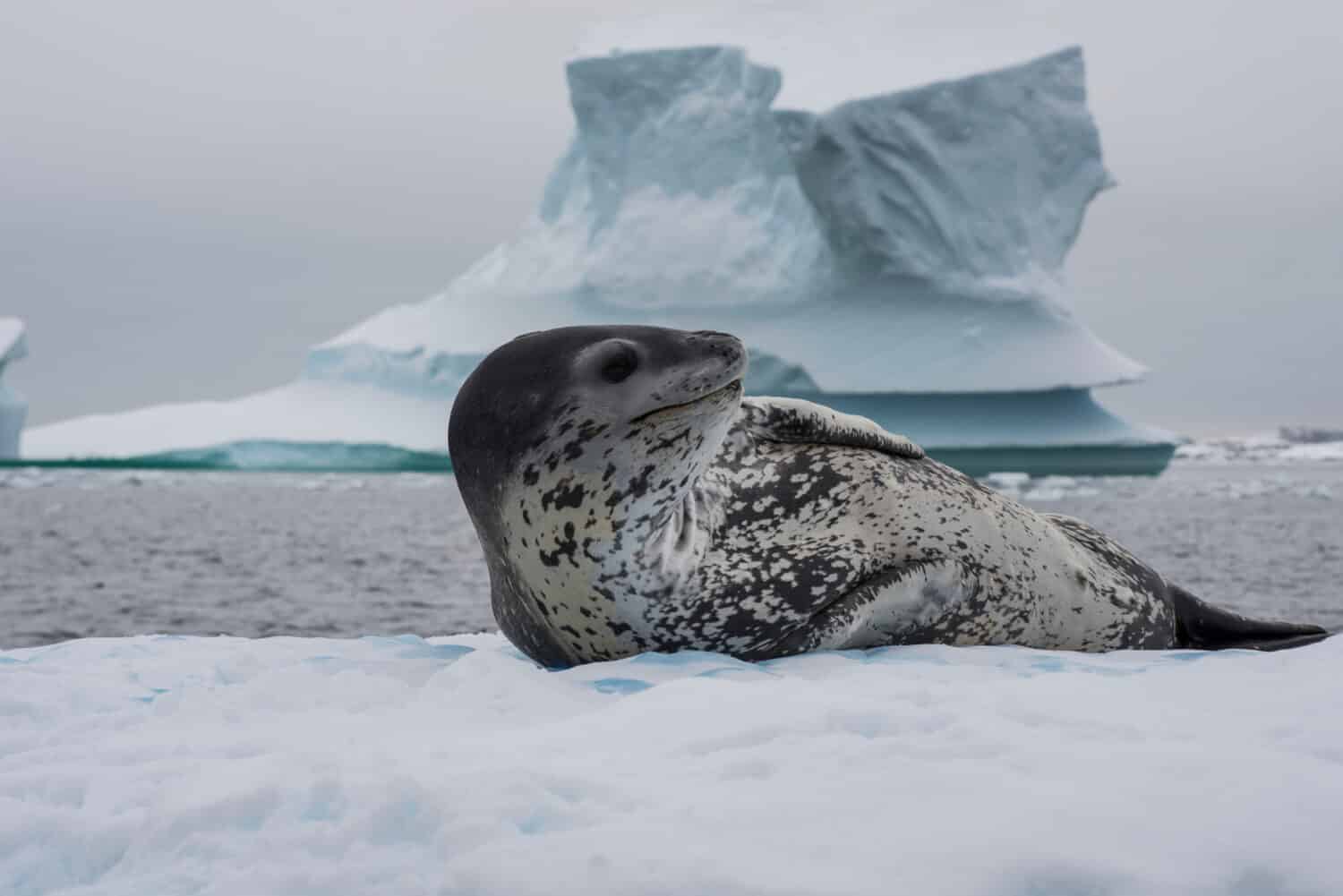
Leopard seals sleep on ice above the water.
©vladsilver/Shutterstock.com
On land, they can shoot themselves across icy surfaces up to 35 miles per hour. This is not only impressive but fun to watch! The seal will haul its large body out onto the ice when it needs to rest, but when it does so, it moves awkwardly and uses the time to recuperate from its efforts in the water.
Great White Sharks can swim 35 miles per hour and are strong swimmers. They are the second-fastest sharks in the world, averaging 25 miles per hour as they move about. Their sleek form and strong tails are the key to their speed.
To help them travel through the water, the powerful muscles in their tails flex back and forth and side to side. Sharks may tighten their tails mid-swing, changing the movement to adapt and produce quicker speeds.
Although leopard seals are more agile, it’s safe to say great white sharks win this round. Their slower speed in the water is faster than the maximum speed of the seal.
Leopard Seals vs. Great White Sharks: Defense
Sharks are not solely dependent on their size and powerful jaws to defend themselves. Great whites are well-adapted predators that can outsmart and outswim other ocean creatures with ease. A shark has to count on every one of his senses, intelligence, and strength to defend himself in the wild.
Some sharks purposefully bury themselves in the ocean floor, disguising themselves to evade detection. The shark can communicate with body language, proactively protecting himself by trying to avoid violent conflicts thanks to both his quick mind and incredible eyesight.
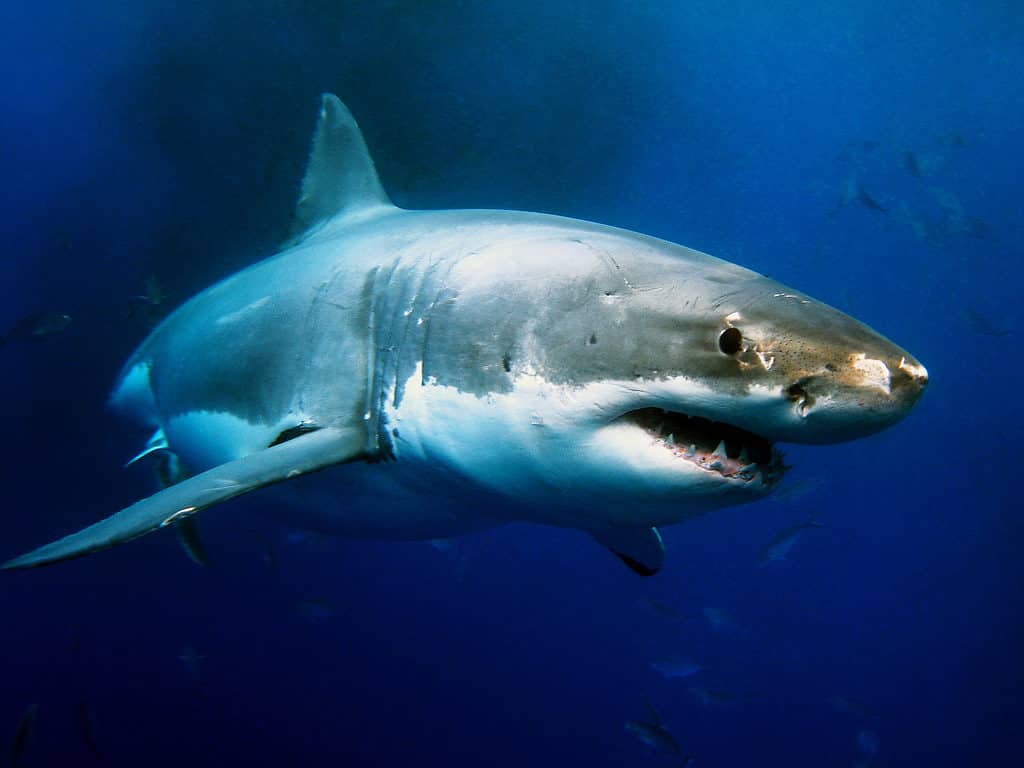
Humans are the other predator of Great White Sharks.
©iStock.com/Whitepointer
Sharks beat down, confuse, and rip apart their prey with an arsenal of strong body slams and ferocious bites. Sharks typically rely on surprising their prey and potential enemies by creeping up on them from beneath. This gives the apex predator a leg up from the start of the conflict.
Leopard seals first appear to be easy prey for predators and other animals that would contend for food and habitat because of their huge bodies and short fins. These aquatic mammals are not helpless, though. A leopard seal will typically choose flight over combat if at all conceivable.
The challenge of harming a seal is part of its protection. It takes a considerably larger animal to bite and consume a seal because they have several inches of blubber. Another aspect of their defense is their capacity to live both on land and in water.
The seal’s aerodynamic physique makes it easier for it to outmaneuver predators while in the water, and it can leap fast onto land to completely escape the water-based predator. The fact that great white sharks cannot survive outside of the water is also fortunate for us as humans!
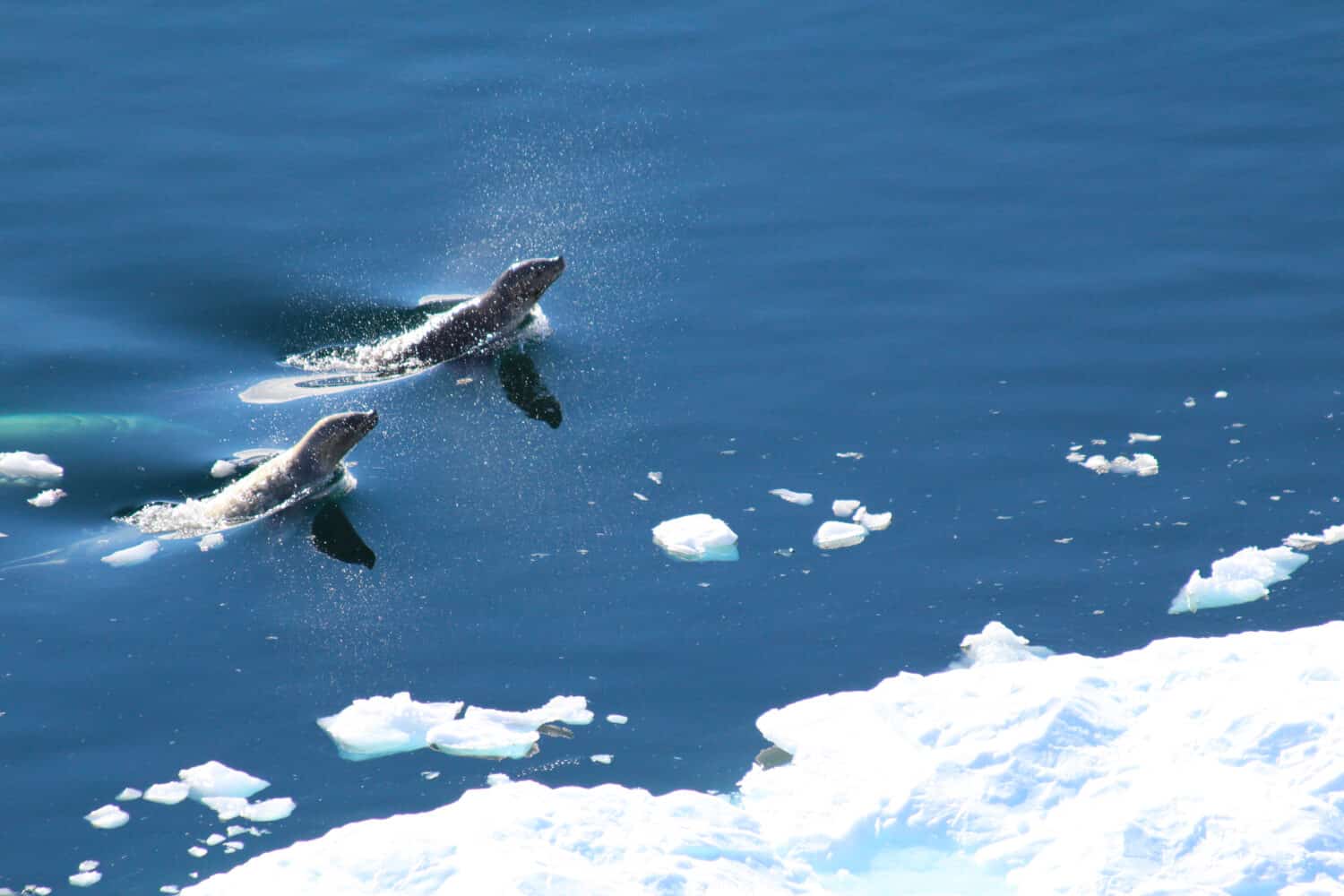
Leopard seals will occasionally hunt in pairs.
©Marco Ramerini/Shutterstock.com
When a great white shark grabs them, leopard seals will only bite and struggle to defend themselves. We think the crown for defense may be a tie! Although sharks are apex predators, the leopard seal has incredible defensive skills that keep it safe.
Leopard Seals vs. Great White Sharks: Predatory Behavior
A Leopard Seal’s major food source is krill, but they sometimes hunt penguins. It’s important to note that they leave the penguins’ skeleton, feet, and head alone. Larger seals may even eat smaller, weaker seals as they lurk near ice shelves to snare birds or fish.
If you’re ever in the same water as these creatures, take special precautions to keep a safe distance while approaching leopard seals because there has been one recorded instance of a human attack.
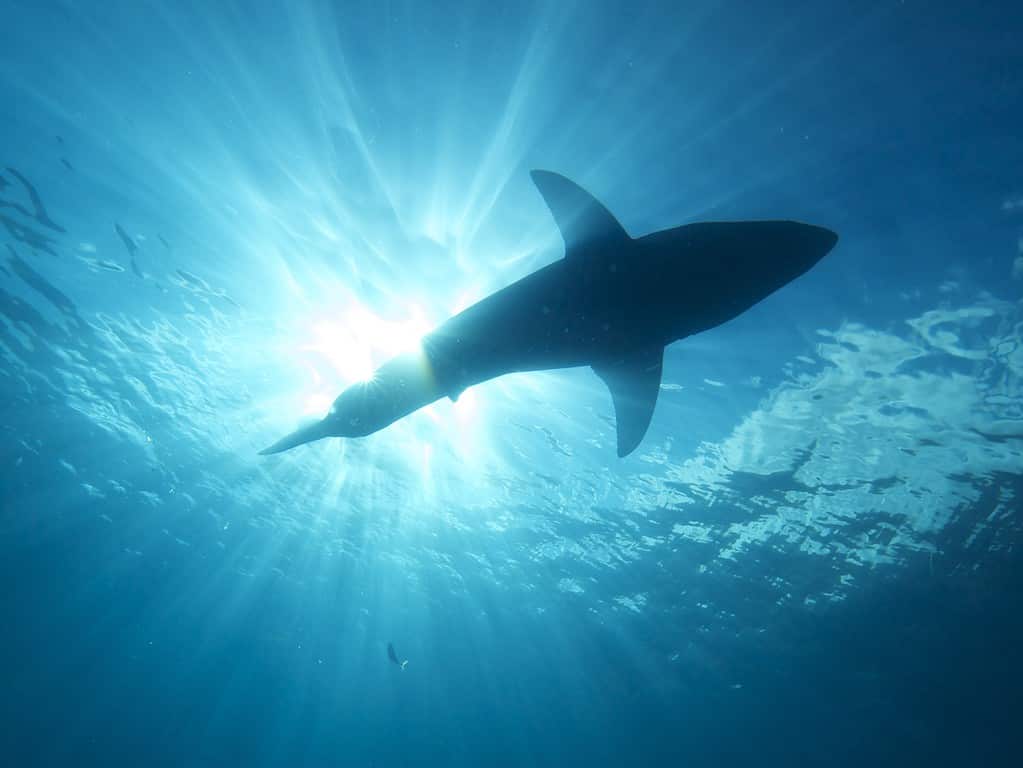
Great white sharks are only visible to animals under them.
©Elias Levy / CC BY 2.0 – License
Leopard seals are known to be ambush predators as well. They will patiently stalk an animal in order to have a fresh meal. With that being said, the crown for this category is going to the Great White Shark.
You don’t get the title of being an apex predator without having outstanding predatory behavior. The Great White generally swims along the bottom to follow its prey before striking with a lightning-fast upward attack. The great white is a well-known aggressive predator with a very powerful body that is capable of pursuing some of the ocean’s quickest swimmers.
Other Animals That Could Beat a Leopard Seal
Despite great white sharks taking the top spot for this battle, did you know that the only predator of leopard seals on record is the orca? Leopard seals can survive in the wild for up to 26 years if they are able to avoid the orcas. Due to the fact that orcas spawn in Antarctic seas and there are over 70,000 orcas in that region, leopard seals frequently become food for orcas.
The photo featured at the top of this post is ©
Thank you for reading! Have some feedback for us? Contact the AZ Animals editorial team.






